Properties and Applications of the β Phase Poly(vinylidene fluoride)
Abstract
1. Introduction
2. Phases Characters of PVDF
3. Processing Techniques of β Phase PVDF
3.1. Phase Transition Methods
3.2. Solvent Casting
3.2.1. Electrospinning
3.2.2. Langmuir–Blodgett
3.2.3. Spin-Coating
3.2.4. Solvent Evaporation
3.3. Copolymers
3.4. Composites: Inclusion of Fillers within the Polymer Matrix
4. The Electroactive Properties of the β Phase PVDF
4.1. Piezoelectric Effect
4.2. Pyroelectric Effect
4.3. Ferroelectric Effect
5. Applications of the β Phase PVDF
5.1. Sensor and Actuator Applications
5.2. Spin Valve Devices
5.3. Magnetoelectric Materials
5.4. Energy Harvesting Applications
5.5. Tissue Engineering
5.6. Modelling Studies for PVDF
5.7. Reversible 3D Shape Transformation of the PVDF Film
6. Conclusions and Perspective
Acknowledgments
Conflicts of Interest
References
- Lovinger, A.J. Poly(vinylidene fluoride). In Developments in Crystalline Polymers—1; Springer: Dordrecht, The Netherlands, 1982; pp. 195–273. [Google Scholar]
- Lovinger, A.J. Annealing of poly(vinylidene fluoride) and formation of a fifth phase. Macromolecules 1982, 15, 40–44. [Google Scholar] [CrossRef]
- Prest, W., Jr.; Luca, D. The formation of the γ phase from the α and β polymorphs of polyvinylidene fluoride. J. Appl. Phys. 1978, 49, 5042–5047. [Google Scholar] [CrossRef]
- El Mohajir, B.-E.; Heymans, N. Changes in structural and mechanical behaviour of PVDF with processing and thermomechanical treatments. 1. Change in structure. Polymer 2001, 42, 5661–5667. [Google Scholar] [CrossRef]
- Gregorio, R., Jr.; Cestari, M. Effect of crystallization temperature on the crystalline phase content and morphology of poly(vinylidene fluoride). J. Polym. Sci. Part B Polym. Phys. 1994, 32, 859–870. [Google Scholar] [CrossRef]
- Salimi, A.; Yousefi, A. Analysis method: FTIR studies of β phase crystal formation in stretched PVDF films. Polym. Test. 2003, 22, 699–704. [Google Scholar] [CrossRef]
- Pan, H.; Na, B.; Lv, R.; Li, C.; Zhu, J.; Yu, Z. Polar phase formation in poly(vinylidene fluoride) induced by melt annealing. J. Polym. Sci. Part B Polym. Phys. 2012, 50, 1433–1437. [Google Scholar] [CrossRef]
- Kang, S.J.; Park, Y.J.; Sung, J.; Jo, P.S.; Park, C.; Kim, K.J.; Cho, B.O. Spin cast ferroelectric beta poly(vinylidene fluoride) thin films via rapid thermal annealing. Appl. Phys. Lett. 2008, 92, 012921. [Google Scholar] [CrossRef]
- Song, R.; Yang, D.; He, L. Effect of surface modification of nanosilica on crystallization, thermal and mechanical properties of poly(vinylidene fluoride). J. Mater. Sci. 2007, 42, 8408–8417. [Google Scholar] [CrossRef]
- Dutta, B.; Kar, E.; Bose, N.; Mukherjee, S. Significant enhancement of the electroactive β phase of PVDF by incorporating hydrothermally synthesized copper oxide nanoparticles. RSC Adv. 2015, 5, 105422–105434. [Google Scholar] [CrossRef]
- Rutledge, G.; Carbeck, J.; Lacks, D. Modeling the Electrical Properties of Polymers; Technical Papers of the Annual Technical Conference-Society of Plastics Engineers Incorporated; Society Of Plastics Engineers Inc.: Indianapolis, IN, USA, 1996; pp. 2163–2166. [Google Scholar]
- Lando, J.; Olf, H.; Peterlin, A. Nuclear magnetic resonance and X-ray determination of the structure of poly(vinylidene fluoride). J. Polym. Sci. Part A Polym. Chem. 1966, 4, 941–951. [Google Scholar] [CrossRef]
- Wan, C.; Bowen, C.R. Multiscale-structuring of polyvinylidene fluoride for energy harvesting: The impact of molecular-, micro- and macro-structure. J. Mater. Chem. A 2017, 5, 3091–3128. [Google Scholar] [CrossRef]
- Gregorio, R. Determination of the α, β, and γ crystalline phases of poly(vinylidene fluoride) films prepared at different conditions. J. Appl. Polym. Sci. 2006, 100, 3272–3279. [Google Scholar] [CrossRef]
- Lopes, A.; Costa, C.M.; Tavares, C.; Neves, I.; Lanceros-Mendez, S. Nucleation of the electroactive γ phase and enhancement of the optical transparency in low filler content poly(vinylidene)/clay nanocomposites. J. Phys. Chem. C 2011, 115, 18076–18082. [Google Scholar] [CrossRef]
- Martins, P.; Lopes, A.; Lanceros-Mendez, S. Electroactive phases of poly(vinylidene fluoride): Determination, processing and applications. Prog. Polym. Sci. 2014, 39, 683–706. [Google Scholar] [CrossRef]
- Sajkiewicz, P.; Wasiak, A.; Gocłowski, Z. Phase transitions during stretching of poly(vinylidene fluoride). Eur. Polym. J. 1999, 35, 423–429. [Google Scholar] [CrossRef]
- Bachmann, M.; Gordon, W.; Koenig, J.; Lando, J. An infrared study of phase-III poly(vinylidene fluoride). J. Appl. Phys. 1979, 50, 6106–6112. [Google Scholar] [CrossRef]
- Boccaccio, T.; Bottino, A.; Capannelli, G.; Piaggio, P. Characterization of PVDF membranes by vibrational spectroscopy. J. Membr. Sci. 2002, 210, 315–329. [Google Scholar] [CrossRef]
- Imamura, R.; Silva, A.; Gregorio, R. γ→β Phase transformation induced in poly(vinylidene fluoride) by stretching. J. Appl. Polym. Sci. 2008, 110, 3242–3246. [Google Scholar] [CrossRef]
- Sim, L.; Majid, S.; Arof, A. Characteristics of PEMA/PVdF-HFP blend polymeric gel films incorporated with lithium triflate salt in electrochromic device. Solid State Ion. 2012, 209, 15–23. [Google Scholar] [CrossRef]
- Sim, L.; Majid, S.; Arof, A. FTIR studies of PEMA/PVdF-HFP blend polymer electrolyte system incorporated with LiCF3SO3 salt. Vib. Spectrosc. 2012, 58, 57–66. [Google Scholar] [CrossRef]
- Nalwa, H.S. Ferroelectric Polymers: Chemistry: Physics, and Applications; CRC Press: Boca Raton, FL, USA, 1995. [Google Scholar]
- Lovinger, A.J. Crystallization of the β phase of poly(vinylidene fluoride) from the melt. Polymer 1981, 22, 412–413. [Google Scholar] [CrossRef]
- Doll, W.; Lando, J. The polymorphism of poly(vinylidene fluoride) IV. The structure of high-pressure-crystallized poly(vinylidene fluoride). J. Macromol. Sci. Part B 1970, 4, 889–896. [Google Scholar] [CrossRef]
- Yang, D.; Chen, Y. β phase formation of poly(vinylidene fluoride) from the melt induced by quenching. J. Mater. Sci. Lett. 1987, 6, 599–603. [Google Scholar] [CrossRef]
- Broadhurst, M.; Davis, G.; McKinney, J.; Collins, R. Piezoelectricity and pyroelectricity in polyvinylidene fluoride—A model. J. Appl. Phys. 1978, 49, 4992–4997. [Google Scholar] [CrossRef]
- Jungnickel, B. Poly(vinylidene fluoride) (overview). In Polymeric Material Handbook; Salamone, J.C., Ed.; CRC Press: New York, NY, USA, 1999. [Google Scholar]
- Gregorio, R.; Ueno, E. Effect of crystalline phase, orientation and temperature on the dielectric properties of poly(vinylidene fluoride) (PVDF). J. Mater. Sci. 1999, 34, 4489–4500. [Google Scholar] [CrossRef]
- Lanceros-Mendez, S.; Mano, J.; Costa, A.; Schmidt, V. FTIR and DSC studies of mechanically deformed β PVDF films. J. Macromol. Sci. Part B 2001, 40, 517–527. [Google Scholar] [CrossRef]
- Luongo, J. Far-infrared spectra of piezoelectric polyvinylidene fluoride. J. Polym. Sci. Part B Polym. Phys. 1972, 10, 1119–1123. [Google Scholar] [CrossRef]
- Kawai, H. The piezoelectricity of poly(vinylidene fluoride). Jpn. J. Appl. Phys. 1969, 8, 975. [Google Scholar] [CrossRef]
- Li, L.; Zhang, M.; Rong, M.; Ruan, W. Studies on the transformation process of PVDF from α to β phase by stretching. RSC Adv. 2014, 4, 3938–3943. [Google Scholar] [CrossRef]
- Sencadas, V.; Moreira, M.V.; Lanceros-Méndez, S.; Pouzada, A.S.; Filho, R.G. α to β Transformation on PVDF films obtained by uniaxial stretch. Mater. Sci. Forum 2006, 514–516, 872–876. [Google Scholar] [CrossRef]
- Mohammadi, B.; Yousefi, A.A.; Bellah, S.M. Effect of tensile strain rate and elongation on crystalline structure and piezoelectric properties of PVDF thin films. Polym. Test. 2007, 26, 42–50. [Google Scholar] [CrossRef]
- Hattori, T.; Kanaoka, M.; Ohigashi, H. Improved piezoelectricity in thick lamellar β form crystals of poly(vinylidene fluoride) crystallized under high pressure. J. Appl. Phys. 1996, 79, 2016–2022. [Google Scholar] [CrossRef]
- Sharma, M.; Madras, G.; Bose, S. Process induced electroactive β polymorph in PVDF: Effect on dielectric and ferroelectric properties. Phys. Chem. Chem. Phys. 2014, 16, 14792–14799. [Google Scholar] [CrossRef] [PubMed]
- Bohlen, M.; Bolton, K. Inducing the β phase of poly(vinylidene fluoride)—A review. Annu. Rev. Nanosci. Nanotechnol. 2014, 1, 150110. [Google Scholar]
- Ramos, M.M.; Correia, H.M.; Lanceros-Mendez, S. Atomistic modelling of processes involved in poling of PVDF. Comput. Mater. Sci. 2005, 33, 230–236. [Google Scholar] [CrossRef]
- Schwartz, M. Encyclopedia of Smart Materials; Wiley: New York, NY, USA, 2002; p. 811. [Google Scholar]
- Hsu, S.; Lu, F.; Waldman, D.; Muthukumar, M. Analysis of the crystalline phase transformation of poly(vinylidene fluoride). Macromolecules 1985, 18, 2583–2587. [Google Scholar] [CrossRef]
- Southgate, P. Room-temperature poling and morphology changes in pyroelectric polyvinylidene fluoride. Appl. Phys. Lett. 1976, 28, 250–252. [Google Scholar] [CrossRef]
- Martín, J.; Zhao, D.; Lenz, T.; Katsouras, I.; de Leeuw, D.M.; Stingelin, N. Solid-state-processing of δ PVDF. Mater. Horiz. 2017, 4, 408–414. [Google Scholar] [CrossRef]
- Rastogi, A.C.; Desu, S.B. Ferroelectric Poly(vinylidene fluoride) Thin Films Grown by Low-Pressure Chemical Vapor Polymerization. Chem. Vap. Depos. 2006, 12, 742–750. [Google Scholar] [CrossRef]
- Benz, M.; Euler, W.B.; Gregory, O.J. The role of solution phase water on the deposition of thin films of poly(vinylidene fluoride). Macromolecules 2002, 35, 2682–2688. [Google Scholar] [CrossRef]
- Ribeiro, C.; Sencadas, V.; Ribelles, J.L.G.; Lanceros-Méndez, S. Influence of processing conditions on polymorphism and nanofiber morphology of electroactive poly(vinylidene fluoride) electrospun membranes. Soft Mater. 2010, 8, 274–287. [Google Scholar] [CrossRef]
- Ramakrishna, S.; Fujihara, K.; Teo, W.; Lim, T.-C.; Ma, Z. An Introduction to Electrospinning and Nanofibers; World Scientific Publishing Company: Singapore, 2005. [Google Scholar]
- Andrew, J.; Mack, J.; Clarke, D. Electrospinning of polyvinylidene difluoride-based nanocomposite fibers. J. Mater. Res. 2008, 23, 105–114. [Google Scholar] [CrossRef]
- Ren, X.; Dzenis, Y. Novel continuous poly(vinylidene fluoride) nanofibers. MRS Online Proc. Libr. Arch. 2006, 920. [Google Scholar] [CrossRef]
- Zhao, Z.; Li, J.; Yuan, X.; Li, X.; Zhang, Y.; Sheng, J. Preparation and properties of electrospun poly(vinylidene fluoride) membranes. J. Appl. Polym. Sci. 2005, 97, 466–474. [Google Scholar] [CrossRef]
- Zheng, J.; He, A.; Li, J.; Han, C.C. Polymorphism control of poly(vinylidene fluoride) through electrospinning. Macromol. Rapid Commun. 2007, 28, 2159–2162. [Google Scholar] [CrossRef]
- Yee, W.A.; Kotaki, M.; Liu, Y.; Lu, X. Morphology, polymorphism behavior and molecular orientation of electrospun poly(vinylidene fluoride) fibers. Polymer 2007, 48, 512–521. [Google Scholar] [CrossRef]
- Choi, S.W.; Jo, S.M.; Lee, W.S.; Kim, Y.R. An electrospun poly(vinylidene fluoride) nanofibrous membrane and its battery applications. Adv. Mater. 2003, 15, 2027–2032. [Google Scholar] [CrossRef]
- Xiao, Q.; Wang, X.; Li, W.; Li, Z.; Zhang, T.; Zhang, H. Macroporous polymer electrolytes based on PVDF/PEO-b-PMMA block copolymer blends for rechargeable lithium ion battery. J. Membr. Sci. 2009, 334, 117–122. [Google Scholar] [CrossRef]
- Klinge, U.; Klosterhalfen, B.; Öttinger, A.; Junge, K.; Schumpelick, V. PVDF as a new polymer for the construction of surgical meshes. Biomaterials 2002, 23, 3487–3493. [Google Scholar] [CrossRef]
- Choi, S.W.; Kim, J.R.; Ahn, Y.R.; Jo, S.M.; Cairns, E.J. Characterization of electrospun PVDF fiber-based polymer electrolytes. Chem. Mater. 2007, 19, 104–115. [Google Scholar] [CrossRef]
- Roberts, G. Langmuir–Blodgett Films; Springer Science & Business Media: Berlin, Germany, 2013. [Google Scholar]
- Chen, S.; Li, X.; Yao, K.; Tay, F.E.H.; Kumar, A.; Zeng, K. Self-polarized ferroelectric PVDF homopolymer ultra-thin films derived from Langmuir–Blodgett deposition. Polymer 2012, 53, 1404–1408. [Google Scholar] [CrossRef]
- Jiang, Y.; Ye, Y.; Yu, J.; Yang, Y.; Xu, J.; Wu, Z. A study on ferroelectric PVDF ultrathin films prepared by LB technique. Integr. Ferroelectr. 2007, 88, 21–26. [Google Scholar] [CrossRef]
- Jones, C.A.; Petty, M.C.; Roberts, G.G. Langmuir–Blodgett films: A new class of pyroelectric materials. IEEE Trans. Ultrason. Ferroelectr. Freq. Control 1988, 35, 736–740. [Google Scholar] [CrossRef] [PubMed]
- Zhu, H.; Mitsuishi, M.; Miyashita, T. Facile Preparation of Highly Oriented Poly(vinylidene fluoride) Langmuir–Blodgett Nanofilms Assisted by Amphiphilic Polymer Nanosheets. Macromolecules 2012, 45, 9076–9084. [Google Scholar] [CrossRef]
- Zhu, H.; Yamamoto, S.; Matsui, J.; Miyashita, T.; Mitsuishi, M. Asymmetric Ferroelectric Switching Based on an Al/PVDF Langmuir–Blodgett Nanofilm/PEDOT:PSS/Al Device. Mol. Cryst. Liq. Cryst. 2015, 618, 89–94. [Google Scholar] [CrossRef]
- Kliem, H.; Tadros-Morgane, R. Extrinsic versus intrinsic ferroelectric switching: Experimental investigations using ultra-thin PVDF Langmuir–Blodgett films. J. Phys. D Appl. Phys. 2005, 38, 1860. [Google Scholar] [CrossRef]
- Zhang, X.; Tong, J.; Zhu, H.; Wang, Z.; Zhou, L.; Wang, S.; Miyashita, T.; Mitsuishi, M.; Qin, G. Room temperature magnetoresistance effects in ferroelectric poly(vinylidene fluoride) spin valves. J. Mater. Chem. C 2017, 5, 5055–5062. [Google Scholar] [CrossRef]
- Ramasundaram, S.; Yoon, S.; Kim, K.J.; Lee, J.S. Direct Preparation of Nanoscale Thin Films of Poly(vinylidene fluoride) Containing β Crystalline Phase by Heat-Controlled Spin Coating. Macromol. Chem. Phys. 2008, 209, 2516–2526. [Google Scholar] [CrossRef]
- Ramasundaram, S.; Yoon, S.; Kim, K.J.; Lee, J.S.; Park, C. Crystalline structure and ferroelectric response of poly(vinylidene fluoride)/organically modified silicate thin films prepared by heat controlled spin coating. Macromol. Chem. Phys. 2009, 210, 951–960. [Google Scholar] [CrossRef]
- Cardoso, V.; Minas, G.; Costa, C.M.; Tavares, C.; Lanceros-Mendez, S. Micro and nanofilms of poly(vinylidene fluoride) with controlled thickness, morphology and electroactive crystalline phase for sensor and actuator applications. Smart Mater. Struct. 2011, 20, 087002. [Google Scholar] [CrossRef]
- He, X.; Yao, K. Crystallization mechanism and piezoelectric properties of solution-derived ferroelectric poly(vinylidene fluoride) thin films. Appl. Phys. Lett. 2006, 89, 112909. [Google Scholar] [CrossRef]
- Sakata, J.; Mochizuki, M. Preparation of organic thin films by an electrospray technique I. Crystal forms and their orientation in poly(vinylidene flouride) films. Thin Solid Films 1991, 195, 175–184. [Google Scholar] [CrossRef]
- Park, S.H.; Lee, D.C. A study of the electrical stability characteristics of a PVDF organic thin film fabricated by using the thermal vapor deposition method. J. Korean Phys. Soc. 1999, 35, 431–437. [Google Scholar]
- Noda, K.; Ishida, K.; Horiuchi, T.; Matsushige, K.; Kubono, A. Structures of vinylidene fluoride oligomer thin films on alkali halide substrate. J. Appl. Phys. 1999, 86, 3688–3693. [Google Scholar] [CrossRef]
- Ouyang, J.; Chu, C.-W.; Tseng, R.J.-H.; Prakash, A.; Yang, Y. Organic memory device fabricated through solution processing. Proc. IEEE 2005, 93, 1287–1296. [Google Scholar] [CrossRef]
- Mcculloch, I. Thin films: Rolling out organic electronics. Nat. Mater. 2005, 4, 583–584. [Google Scholar] [CrossRef] [PubMed]
- Sencadas, V.; Filho, R.G.; Lanceros-Mendez, S. Processing and characterization of a novel nonporous poly(vinilidene fluoride) films in the β phase. J. Non-Cryst. Solids 2006, 352, 2226–2229. [Google Scholar] [CrossRef]
- Branciforti, M.C.; Sencadas, V.; Lanceros-Mendez, S.; Gregorio, R. New technique of processing highly oriented poly(vinylidene fluoride) films exclusively in the β phase. J. Polym. Sci. Part B Polym. Phys. 2007, 45, 2793–2801. [Google Scholar] [CrossRef]
- Voet, V.S.D.; Hermida-Merino, D.; ten Brinke, G.; Loos, K. Block copolymer route towards poly(vinylidene fluoride)/poly(methacrylic acid)/nickel nanocomposites. RSC Adv. 2013, 3, 7938–7946. [Google Scholar] [CrossRef]
- Golzari, N.; Adams, J.; Beuermann, S. Inducing β phase crystallinity in block copolymers of vinylidene fluoride with methyl methacrylate or styrene. Polymers 2017, 9, 306. [Google Scholar] [CrossRef]
- Lovinger, A.J.; Furukawa, T.; Davis, G.; Broadhurst, M. Crystallographic changes characterizing the Curie transition in three ferroelectric copolymers of vinylidene fluoride and trifluoroethylene: 1. As-crystallized samples. Polymer 1983, 24, 1225–1232. [Google Scholar] [CrossRef]
- Furukawa, T.; Johnson, G.; Bair, H.; Tajitsu, Y.; Chiba, A.; Fukada, E. Ferroelectric phase transition in a copolymer of vinylidene fluoride and trifluoroethylene. Ferroelectrics 1981, 32, 61–67. [Google Scholar] [CrossRef]
- Ohigashi, H.; Omote, K.; Gomyo, T. Formation of “single crystalline films” of ferroelectric copolymers of vinylidene fluoride and trifluoroethylene. Appl. Phys. Lett. 1995, 66, 3281–3283. [Google Scholar] [CrossRef]
- Künstler, W.; Wegener, M.; Seiß, M.; Gerhard-Multhaupt, R. Preparation and assessment of piezo- and pyroelectric poly(vinylidene fluoride-hexafluoropropylene) copolymer films. Appl. Phys. A Mater. Sci. Process. 2001, 73, 641–645. [Google Scholar] [CrossRef]
- Huan, Y.; Liu, Y.; Yang, Y. Simultaneous stretching and static electric field poling of poly(vinylidene fluoride-hexafluoropropylene) copolymer films. Polym. Eng. Sci. 2007, 47, 1630–1633. [Google Scholar] [CrossRef]
- Ameduri, B. From vinylidene fluoride (VDF) to the applications of VDF-containing polymers and copolymers: Recent developments and future trends. Chem. Rev. 2009, 109, 6632–6686. [Google Scholar] [CrossRef] [PubMed]
- Li, Z.; Wang, Y.; Cheng, Z.-Y. Electromechanical properties of poly(vinylidene-fluoride-chlorotrifluoroethylene) copolymer. Appl. Phys. Lett. 2006, 88, 062904. [Google Scholar] [CrossRef]
- Ye, H.J.; Shao, W.Z.; Zhen, L. Crystallization kinetics and phase transformation of poly(vinylidene fluoride) films incorporated with functionalized baTiO3 nanoparticles. J. Appl. Polym. Sci. 2013, 129, 2940–2949. [Google Scholar] [CrossRef]
- Mendes, S.F.; Costa, C.M.; Caparrós, C.; Sencadas, V.; Lanceros-Méndez, S. Effect of filler size and concentration on the structure and properties of poly(vinylidene fluoride)/BaTiO3 nanocomposites. J. Mater. Sci. 2012, 47, 1378–1388. [Google Scholar] [CrossRef]
- Priya, L.; Jog, J. Poly(vinylidene fluoride)/clay nanocomposites prepared by melt intercalation: Crystallization and dynamic mechanical behavior studies. J. Polym. Sci. Part B Polym. Phys. 2002, 40, 1682–1689. [Google Scholar] [CrossRef]
- Ma, W.; Zhang, J.; Chen, S.; Wang, X. β Phase of poly(vinylidene fluoride) formation in poly(vinylidene fluoride)/poly(methyl methacrylate) blend from solutions. Appl. Surf. Sci. 2008, 254, 5635–5642. [Google Scholar] [CrossRef]
- An, N.; Liu, H.; Ding, Y.; Zhang, M.; Tang, Y. Preparation and electroactive properties of a PVDF/nano-TiO2 composite film. Appl. Surf. Sci. 2011, 257, 3831–3835. [Google Scholar] [CrossRef]
- Martins, P.; Caparros, C.; Gonçalves, R.; Martins, P.; Benelmekki, M.; Botelho, G.; Lanceros-Mendez, S. Role of nanoparticle surface charge on the nucleation of the electroactive β poly(vinylidene fluoride) nanocomposites for sensor and actuator applications. J. Phys. Chem. C 2012, 116, 15790–15794. [Google Scholar] [CrossRef]
- Wang, W.; Zhang, S.; Srisombat, L.-O.; Lee, T.R.; Advincula, R.C. Gold-Nanoparticle- and Gold-Nanoshell-Induced Polymorphism in Poly(vinylidene fluoride). Macromol. Mater. Eng. 2011, 296, 178–184. [Google Scholar] [CrossRef]
- Xing, C.; Zhao, L.; You, J.; Dong, W.; Cao, X.; Li, Y. Impact of ionic liquid-modified multiwalled carbon nanotubes on the crystallization behavior of poly(vinylidene fluoride). J. Phys. Chem. B 2012, 116, 8312–8320. [Google Scholar] [CrossRef] [PubMed]
- Xing, C.; Guan, J.; Li, Y.; Li, J. Effect of a room-temperature ionic liquid on the structure and properties of electrospun poly(vinylidene fluoride) nanofibers. ACS Appl. Mater. Interfaces 2014, 6, 4447–4457. [Google Scholar] [CrossRef] [PubMed]
- Martins, P.; Costa, C.M.; Lanceros-Mendez, S. Nucleation of electroactive β phase poly(vinilidene fluoride) with CoFe2O4 and NiFe2O4 nanofillers: A new method for the preparation of multiferroic nanocomposites. Appl. Phys. A 2011, 103, 233–237. [Google Scholar] [CrossRef]
- Martins, P.; Costa, C.M.; Benelmekki, M.; Botelho, G.; Lanceros-Mendez, S. On the origin of the electroactive poly(vinylidene fluoride) β phase nucleation by ferrite nanoparticles via surface electrostatic interactions. CrystEngComm 2012, 14, 2807–2811. [Google Scholar] [CrossRef]
- Bergman, J.G., Jr.; McFee, J.H.; Crane, G.R. Pyroelectricity and optical second harmonic generation in polyvinylidene fluoride films. Appl. Phys. Lett. 1971, 18, 203–205. [Google Scholar] [CrossRef]
- Nakamura, K.I.; Wada, Y. Piezoelectricity, pyroelectricity, and the electrostriction constant of poly(vinylidene fluoride). J. Polym. Sci. Part B Polym. Phys. 1971, 9, 161–173. [Google Scholar] [CrossRef]
- Fukada, E. History and recent progress in piezoelectric polymers. IEEE Trans. Ultrason. Ferroelectr. Freq. Control 2000, 47, 1277–1290. [Google Scholar] [CrossRef] [PubMed]
- Bune, A.; Zhu, C.; Ducharme, S.; Blinov, L.; Fridkin, V.; Palto, S.; Petukhova, N.; Yudin, S. Piezoelectric and pyroelectric properties of ferroelectric Langmuir–Blodgett polymer films. J. Appl. Phys. 1999, 85, 7869–7873. [Google Scholar] [CrossRef]
- Gomes, J.; Nunes, J.S.; Sencadas, V.; Lanceros-Méndez, S. Influence of the β phase content and degree of crystallinity on the piezo- and ferroelectric properties of poly(vinylidene fluoride). Smart Mater. Struct. 2010, 19, 065010. [Google Scholar] [CrossRef]
- Dargaville, T.R.; Celina, M.; Chaplya, P.M. Evaluation of piezoelectric poly(vinylidene fluoride) polymers for use in space environments. I. Temperature limitations. J. Polym. Sci. Part B Polym. Phys. 2005, 43, 1310–1320. [Google Scholar] [CrossRef]
- Nix, E.; Ward, I. The measurement of the shear piezoelectric coefficients of polyvinylidene fluoride. Ferroelectrics 1986, 67, 137–141. [Google Scholar] [CrossRef]
- Lang, S.B.; Das-Gupta, D.K. Pyroelectricity: Fundamentals and applications. In Handbook of Advanced Electronic and Photonic Materials and Devices; Elsevier: Amsterdam, The Netherlands, 2001; pp. 1–55. [Google Scholar]
- Kepler, R.; Anderson, R. Piezoelectricity and pyroelectricity in polyvinylidene fluoride. J. Appl. Phys. 1978, 49, 4490–4494. [Google Scholar] [CrossRef]
- Chynoweth, A. Dynamic method for measuring the pyroelectric effect with special reference to barium titanate. J. Appl. Phys. 1956, 27, 78–84. [Google Scholar] [CrossRef]
- Roberts, G. Polar Langmuir–Blodgett thin film layers for non-linear optical and pyroelectric applications. Ferroelectrics 1989, 91, 21–38. [Google Scholar] [CrossRef]
- Lines, M.E.; Glass, A.M. Principles and Applications of Ferroelectrics and Related Materials; Oxford University Press: Oxford, UK, 1977. [Google Scholar]
- Sagar, R.; Gaur, S.S.; Gaur, M. Effect of BaZrO3 nanoparticles on pyroelectric properties of polyvinylidene fluoride (PVDF). J. Therm. Anal. Calorim. 2017, 128, 1235–1239. [Google Scholar] [CrossRef]
- Furukawa, T.; Date, M.; Fukada, E. Hysteresis phenomena in polyvinylidene fluoride under high electric field. J. Appl. Phys. 1980, 51, 1135–1141. [Google Scholar] [CrossRef]
- Zhu, H.; Yamamoto, S.; Matsui, J.; Miyashita, T.; Mitsuishi, M. Ferroelectricity of poly(vinylidene fluoride) homopolymer Langmuir–Blodgett nanofilms. J. Mater. Chem. C 2014, 2, 6727–6731. [Google Scholar] [CrossRef]
- Furukawa, T. Ferroelectric properties of vinylidene fluoride copolymers. Phase Transit. A Multinatl. J. 1989, 18, 143–211. [Google Scholar] [CrossRef]
- Kepler, R.G.; Anderson, R. Ferroelectric polymers. Adv. Phys. 1992, 41, 1–57. [Google Scholar] [CrossRef]
- Naber, R.C.; Asadi, K.; Blom, P.W.; de Leeuw, D.M.; de Boer, B. Organic nonvolatile memory devices based on ferroelectricity. Adv. Mater. 2010, 22, 933–945. [Google Scholar] [CrossRef] [PubMed]
- Choi, S.-S.; Lee, Y.S.; Joo, C.W.; Lee, S.G.; Park, J.K.; Han, K.-S. Electrospun PVDF nanofiber web as polymer electrolyte or separator. Electrochim. Acta 2004, 50, 339–343. [Google Scholar] [CrossRef]
- Abbrent, S.; Plestil, J.; Hlavata, D.; Lindgren, J.; Tegenfeldt, J.; Wendsjö, Å. Crystallinity and morphology of PVdF–HFP-based gel electrolytes. Polymer 2001, 42, 1407–1416. [Google Scholar] [CrossRef]
- Tsuchida, E.; Ohno, H.; Tsunemi, K. Conduction of lithium ions in polyvinylidene fluoride and its derivatives—I. Electrochim. Acta 1983, 28, 591–595. [Google Scholar] [CrossRef]
- Voice, A.; Southall, J.; Rogers, V.; Matthews, K.; Davies, G.; McIntyre, J.; Ward, I. Thermoreversible polymer gel electrolytes. Polymer 1994, 35, 3363–3372. [Google Scholar] [CrossRef]
- Elimelech, M.; Phillip, W.A. The future of seawater desalination: Energy, technology, and the environment. Science 2011, 333, 712–717. [Google Scholar] [CrossRef] [PubMed]
- Jiang, X.C.; Ding, J.; Kumar, A. Polyurethane–poly(vinylidene fluoride) (PU–PVDF) thin film composite membranes for gas separation. J. Membr. Sci. 2008, 323, 371–378. [Google Scholar] [CrossRef]
- Razmjou, A.; Arifin, E.; Dong, G.; Mansouri, J.; Chen, V. Superhydrophobic modification of TiO2 nanocomposite PVDF membranes for applications in membrane distillation. J. Membr. Sci. 2012, 415, 850–863. [Google Scholar] [CrossRef]
- Peng, P.; Shi, B.; Lan, Y. A review of membrane materials for ethanol recovery by pervaporation. Sep. Sci. Technol. 2010, 46, 234–246. [Google Scholar] [CrossRef]
- Song, H.; Shao, J.; Wang, J.; Zhong, X. The removal of natural organic matter with LiCl–TiO2-doped PVDF membranes by integration of ultrafiltration with photocatalysis. Desalination 2014, 344, 412–421. [Google Scholar] [CrossRef]
- Ambashta, R.D.; Sillanpää, M.E. Membrane purification in radioactive waste management: A short review. J. Environ. Radioact. 2012, 105, 76–84. [Google Scholar] [CrossRef] [PubMed]
- Zaviska, F.; Drogui, P.; Grasmick, A.; Azais, A.; Héran, M. Nanofiltration membrane bioreactor for removing pharmaceutical compounds. J. Membr. Sci. 2013, 429, 121–129. [Google Scholar] [CrossRef]
- Li, M.; Katsouras, I.; Piliego, C.; Glasser, G.; Lieberwirth, I.; Blom, P.W.; de Leeuw, D.M. Controlling the microstructure of poly(vinylidene-fluoride) (PVDF) thin films for microelectronics. J. Mater. Chem. C 2013, 1, 7695–7702. [Google Scholar] [CrossRef]
- Zhou, B.; Powell, A.C. Phase field simulations of early stage structure formation during immersion precipitation of polymeric membranes in 2D and 3D. J. Membr. Sci. 2006, 268, 150–164. [Google Scholar] [CrossRef]
- Benz, M.; Rosenberg, K.J.; Kramer, E.J.; Israelachvili, J.N. The deformation and adhesion of randomly rough and patterned surfaces. J. Phys. Chem. B 2006, 110, 11884–11893. [Google Scholar] [CrossRef] [PubMed]
- Tamura, M.; Yamaguchi, T.; Oyaba, T.; Yoshimi, T. Electroacoustic transducers with piezoelectric high polymer films. J. Audio Eng. Soc. 1975, 23, 21–26. [Google Scholar]
- Ribeiro, C.; Panadero, J.; Sencadas, V.; Lanceros-Méndez, S.; Tamano, M.; Moratal, D.; Salmerón-Sánchez, M.; Ribelles, J.G. Fibronectin adsorption and cell response on electroactive poly(vinylidene fluoride) films. Biomed. Mater. 2012, 7, 035004. [Google Scholar] [CrossRef] [PubMed]
- Jeon, J.-H.; Kang, S.-P.; Lee, S.; Oh, I.-K. Novel biomimetic actuator based on SPEEK and PVDF. Sens. Actuators B Chem. 2009, 143, 357–364. [Google Scholar] [CrossRef]
- Panwar, V.; Cha, K.; Park, J.-O.; Park, S. High actuation response of PVDF/PVP/PSSA based ionic polymer metal composites actuator. Sens. Actuators B Chem. 2012, 161, 460–470. [Google Scholar] [CrossRef]
- Zhang, Y.; Niu, H.; Xie, S.; Zhang, X. Numerical and experimental investigation of active vibration control in a cylindrical shell partially covered by a laminated PVDF actuator. Smart Mater. Struct. 2008, 17, 035024. [Google Scholar] [CrossRef]
- Chen, Z.; Kwon, K.-Y.; Tan, X. Integrated IPMC/PVDF sensory actuator and its validation in feedback control. Sens. Actuators A Phys. 2008, 144, 231–241. [Google Scholar] [CrossRef]
- Snyder, S.D.; Tanaka, N.; Kikushima, Y. The use of optimally shaped piezo-electric film sensors in the active control of free field structural radiation, Part 2: Feedback control. J. Vib. Acoust. 1996, 118, 112–121. [Google Scholar] [CrossRef]
- Shirinov, A.; Schomburg, W. Pressure sensor from a PVDF film. Sens. Actuators A Phys. 2008, 142, 48–55. [Google Scholar] [CrossRef]
- Fujitsuka, N.; Sakata, J.; Miyachi, Y.; Mizuno, K.; Ohtsuka, K.; Taga, Y.; Tabata, O. Monolithic pyroelectric infrared image sensor using PVDF thin film. Sens. Actuators A Phys. 1998, 66, 237–243. [Google Scholar] [CrossRef]
- Murayama, N.; Nakamura, K.; Obara, H.; Segawa, M. The strong piezoelectricity in polyvinylidene fluroide (PVDF). Ultrasonics 1976, 14, 15–24. [Google Scholar] [CrossRef]
- Hurmila, S.; Stubb, H.; Pitkänen, J.; Lahdenperä, K.; Penttinen, A.; Suorsa, V.; Tauriainen, A. Ultrasonic transducers using PVDF. Ferroelectrics 1991, 115, 267–278. [Google Scholar] [CrossRef]
- Mazurek, B.; Janiczek, T.; Chmielowiec, J. Assessment of vehicle weight measurement method using PVDF transducers. J. Electrost. 2001, 51, 76–81. [Google Scholar] [CrossRef]
- Xu, G.; Zhang, M.; Zhou, Q.; Chen, H.; Gao, T.; Li, C.; Shi, G. A small graphene oxide sheet/polyvinylidene fluoride bilayer actuator with large and rapid responses to multiple stimuli. Nanoscale 2017, 9, 17465–17470. [Google Scholar] [CrossRef] [PubMed]
- Wang, F.; Ko, S.Y.; Park, J.O.; Park, S.H.; Kee, C.D. Electroactive polymer actuator based on PVDF and graphene through electrospinning. Adv. Mater. Res. 2015, 1105, 311–314. [Google Scholar] [CrossRef]
- Fukushima, T.; Asaka, K.; Kosaka, A.; Aida, T. Fully Plastic Actuator through Layer-by-Layer Casting with Ionic-Liquid-Based Bucky Gel. Angew. Chem. Int. Ed. 2005, 44, 2410–2413. [Google Scholar] [CrossRef] [PubMed]
- Mukai, K.; Asaka, K.; Kiyohara, K.; Sugino, T.; Takeuchi, I.; Fukushima, T.; Aida, T. High performance fully plastic actuator based on ionic-liquid-based bucky gel. Electrochim. Acta 2008, 53, 5555–5562. [Google Scholar] [CrossRef]
- Saketi, P.; Latifi, S.K.; Hirvonen, J.; Rajala, S.; Vehkaoja, A.; Salpavaara, T.; Lekkala, J.; Kallio, P. PVDF microforce sensor for the measurement of Z-directional strength in paper fiber bonds. Sens. Actuators A Phys. 2015, 222, 194–203. [Google Scholar] [CrossRef]
- Choi, S.-C.; Park, J.-S.; Kim, J.-H. Active damping of rotating composite thin-walled beams using MFC actuators and PVDF sensors. Compos. Struct. 2006, 76, 362–374. [Google Scholar] [CrossRef]
- Ying, Z.; Jiang, Y.; Du, X.; Xie, G.; Yu, J.; Wang, H. PVDF coated quartz crystal microbalance sensor for DMMP vapor detection. Sens. Actuators B Chem. 2007, 125, 167–172. [Google Scholar] [CrossRef]
- Shin, K.-Y.; Lee, J.S.; Jang, J. Highly sensitive, wearable and wireless pressure sensor using free-standing ZnO nanoneedle/PVDF hybrid thin film for heart rate monitoring. Nano Energy 2016, 22, 95–104. [Google Scholar] [CrossRef]
- Yoon, S.; Prabu, A.A.; Ramasundaram, S.; Kim, K.J. PVDF nanoweb touch sensors prepared using electro-spinning process for smart apparels applications. Adv. Sci. Technol. 2008, 60, 52–57. [Google Scholar] [CrossRef]
- Wang, Y.; Zheng, J.; Ren, G.; Zhang, P.; Xu, C. A flexible piezoelectric force sensor based on PVDF fabrics. Smart Mater. Struct. 2011, 20, 045009. [Google Scholar] [CrossRef]
- Al-Saygh, A.; Ponnamma, D.; AlMaadeed, M.A.; Poornima Vijayan, P.; Karim, A.; Hassan, M.K. Flexible Pressure Sensor Based on PVDF Nanocomposites Containing Reduced Graphene Oxide-Titania Hybrid Nanolayers. Polymers 2017, 9, 33. [Google Scholar] [CrossRef]
- Martins, P.; Lasheras, A.; Gutierrez, J.; Barandiaran, J.; Orue, I.; Lanceros-Mendez, S. Optimizing piezoelectric and magnetoelectric responses on CoFe2O4/P(VDF-TrFE) nanocomposites. J. Phys. D Appl. Phys. 2011, 44, 495303. [Google Scholar] [CrossRef]
- Spanu, A.; Pinna, L.; Viola, F.; Seminara, L.; Valle, M.; Bonfiglio, A.; Cosseddu, P. A high-sensitivity tactile sensor based on piezoelectric polymer PVDF coupled to an ultra-low voltage organic transistor. Org. Electron. 2016, 36, 57–60. [Google Scholar] [CrossRef]
- Scott, J.C.; Bozano, L.D. Nonvolatile memory elements based on organic materials. Adv. Mater. 2007, 19, 1452–1463. [Google Scholar] [CrossRef]
- Singh, T.B.; Marjanović, N.; Matt, G.; Sariciftci, N.; Schwödiauer, R.; Bauer, S. Nonvolatile organic field-effect transistor memory element with a polymeric gate electret. Appl. Phys. Lett. 2004, 85, 5409–5411. [Google Scholar] [CrossRef]
- Li, Y.; Sinitskii, A.; Tour, J.M. Electronic two-terminal bistable graphitic memories. Nat. Mater. 2008, 7, 966–971. [Google Scholar] [CrossRef] [PubMed]
- Liang, S.; Yang, H.; Yang, H.; Tao, B.; Djeffal, A.; Chshiev, M.; Huang, W.; Li, X.; Ferri, A.; Desfeux, R. Ferroelectric control of organic/ferromagnetic spinterface. Adv. Mater. 2016, 28, 10204–10210. [Google Scholar] [CrossRef] [PubMed]
- Eerenstein, W.; Mathur, N.; Scott, J.F. Multiferroic and magnetoelectric materials. Nature 2006, 442, 759–765. [Google Scholar] [CrossRef] [PubMed]
- Kleemann, W.; Binek, C. Multiferroic and magnetoelectric materials. In Magnetic Nanostructures; Springer: Berlin, Germany, 2013; pp. 163–187. [Google Scholar]
- Martins, P.; Lanceros-Méndez, S. Polymer-based magnetoelectric materials. Adv. Funct. Mater. 2013, 23, 3371–3385. [Google Scholar] [CrossRef]
- Dong, X.; Wang, B.; Wang, K.; Wan, J.; Liu, J.M. Ultra-sensitive detection of magnetic field and its direction using bilayer PVDF/Metglas laminate. Sens. Actuators A Phys. 2009, 153, 64–68. [Google Scholar] [CrossRef]
- Qi, Y.; Jafferis, N.T.; Lyons, K., Jr.; Lee, C.M.; Ahmad, H.; McAlpine, M.C. Piezoelectric ribbons printed onto rubber for flexible energy conversion. Nano Lett. 2010, 10, 524–528. [Google Scholar] [CrossRef] [PubMed]
- Gutiérrez, J.; Lasheras, A.; Barandiarán, J.M.; Vilas, J.L.; Sebastián, M.S.; León, L.M. Temperature response of magnetostrictive/piezoelectric polymer magnetoelectric laminates. MRS Online Proc. Libr. Arch. 2012, 1398. [Google Scholar] [CrossRef]
- Fiebig, M. Revival of the magnetoelectric effect. J. Phys. D Appl. Phys. 2005, 38, R123. [Google Scholar] [CrossRef]
- Nan, C.; Bichurin, M.; Dong, S.; Viehland, D.; Srinivasan, G. Multiferroic magnetoelectric composites: Historical perspective, status, and future directions. J. Appl. Phys. 2008, 103, 031101. [Google Scholar] [CrossRef]
- Chu, Y.-H.; Martin, L.W.; Holcomb, M.B.; Gajek, M.; Han, S.-J.; He, Q.; Balke, N.; Yang, C.-H.; Lee, D.; Hu, W. Electric-field control of local ferromagnetism using a magnetoelectric multiferroic. Nat. Mater. 2008, 7, 478–482. [Google Scholar] [CrossRef] [PubMed]
- Scott, J.; Morrison, F.; Miyake, M.; Zubko, P. Nano-ferroelectric materials and devices. Ferroelectrics 2006, 336, 237–245. [Google Scholar] [CrossRef]
- Zhai, J.; Dong, S.; Xing, Z.; Li, J.; Viehland, D. Giant magnetoelectric effect in Metglas/polyvinylidene-fluoride laminates. Appl. Phys. Lett. 2006, 89, 083507. [Google Scholar] [CrossRef]
- Yang, F.; Wen, Y.; Li, P.; Zheng, M. Magnetoelectric response of magnetostrictive/piezoelectric/magnetostrictive laminate composite. In Proceedings of the 2006 IEEE International Conference on Information Acquisition, Weihai, China, 20–23 August 2006; pp. 1010–1014. [Google Scholar]
- Lasheras, A.; Gutiérrez, J.; Reis, S.; Sousa, D.; Silva, M.; Martins, P.; Lanceros-Mendez, S.; Barandiarán, J.; Shishkin, D.; Potapov, A. Energy harvesting device based on a metallic glass/PVDF magnetoelectric laminated composite. Smart Mater. Struct. 2015, 24, 065024. [Google Scholar] [CrossRef]
- Fang, Z.; Lu, S.; Li, F.; Datta, S.; Zhang, Q.; El Tahchi, M. Enhancing the magnetoelectric response of Metglas/polyvinylidene fluoride laminates by exploiting the flux concentration effect. Appl. Phys. Lett. 2009, 95, 112903. [Google Scholar] [CrossRef]
- Fetisov, L.; Baraban, I.; Fetisov, Y.K.; Burdin, D.; Vopson, M. Nonlinear magnetoelectric effects in flexible composite ferromagnetic—Piezopolymer structures. J. Magn. Magn. Mater. 2017, 441, 628–634. [Google Scholar] [CrossRef]
- Mori, K.; Wuttig, M. Magnetoelectric coupling in Terfenol-D/polyvinylidenedifluoride composites. Appl. Phys. Lett. 2002, 81, 100–101. [Google Scholar] [CrossRef]
- Lu, S.; Jin, J.; Zhou, X.; Fang, Z.; Wang, Q.; Zhang, Q. Large magnetoelectric coupling coefficient in poly(vinylidene fluoride-hexafluoropropylene)/Metglas laminates. J. Appl. Phys. 2011, 110, 104103. [Google Scholar] [CrossRef]
- Lee, M.; Chen, C.Y.; Wang, S.; Cha, S.N.; Park, Y.J.; Kim, J.M.; Chou, L.J.; Wang, Z.L. A hybrid piezoelectric structure for wearable nanogenerators. Adv. Mater. 2012, 24, 1759–1764. [Google Scholar] [CrossRef] [PubMed]
- Kim, H.S.; Kim, J.-H.; Kim, J. A review of piezoelectric energy harvesting based on vibration. Int. J. Precis. Eng. Manuf. 2011, 12, 1129–1141. [Google Scholar] [CrossRef]
- Vatansever, D.; Hadimani, R.; Shah, T.; Siores, E. An investigation of energy harvesting from renewable sources with PVDF andPZT. Smart Mater. Struct. 2011, 20, 055019. [Google Scholar] [CrossRef]
- Gusarov, B.; Gusarova, E.; Viala, B.; Gimeno, L.; Boisseau, S.; Cugat, O.; Vandelle, E.; Louison, B. Thermal energy harvesting by piezoelectric PVDF polymer coupled with shape memory alloy. Sens. Actuators A Phys. 2016, 243, 175–181. [Google Scholar] [CrossRef]
- Tamang, A.; Ghosh, S.K.; Garain, S.; Alam, M.M.; Haeberle, J.; Henkel, K.; Schmeisser, D.; Mandal, D. DNA-Assisted β phase nucleation and alignment of molecular dipoles in PVDF film: A realization of self-poled bioinspired flexible polymer nanogenerator for portable electronic devices. ACS Appl. Mater. Interfaces 2015, 7, 16143–16147. [Google Scholar] [CrossRef] [PubMed]
- Alluri, N.R.; Saravanakumar, B.; Kim, S.-J. Flexible, Hybrid Piezoelectric Film (BaTi(1−x)ZrxO3)/PVDF Nanogenerator as a Self-Powered Fluid Velocity Sensor. ACS Appl. Mater. Interfaces 2015, 7, 9831–9840. [Google Scholar] [CrossRef] [PubMed]
- Granstrom, J.; Feenstra, J.; Sodano, H.A.; Farinholt, K. Energy harvesting from a backpack instrumented with piezoelectric shoulder straps. Smart Mater. Struct. 2007, 16, 1810. [Google Scholar] [CrossRef]
- Farinholt, K.M.; Pedrazas, N.A.; Schluneker, D.M.; Burt, D.W.; Farrar, C.R. An energy harvesting comparison of piezoelectric and ionically conductive polymers. J. Intell. Mater. Syst. Struct. 2009, 20, 633–642. [Google Scholar] [CrossRef]
- Sun, C.; Shi, J.; Bayerl, D.J.; Wang, X. PVDF microbelts for harvesting energy from respiration. Energy Environ. Sci. 2011, 4, 4508–4512. [Google Scholar] [CrossRef]
- Li, S.; Crovetto, A.; Peng, Z.; Zhang, A.; Hansen, O.; Wang, M.; Li, X.; Wang, F. Bi-resonant structure with piezoelectric PVDF films for energy harvesting from random vibration sources at low frequency. Sens. Actuators A Phys. 2016, 247, 547–554. [Google Scholar] [CrossRef]
- Lovinger, A.J. Ferroelectric polymers. Science 1983, 220, 1115–1121. [Google Scholar] [CrossRef] [PubMed]
- Pi, Z.; Zhang, J.; Wen, C.; Zhang, Z.-B.; Wu, D. Flexible piezoelectric nanogenerator made of poly(vinylidenefluoride-co-trifluoroethylene) (PVDF-TrFE) thin film. Nano Energy 2014, 7, 33–41. [Google Scholar] [CrossRef]
- Lallart, M.; Cottinet, P.-J.; Lebrun, L.; Guiffard, B.; Guyomar, D. Evaluation of energy harvesting performance of electrostrictive polymer and carbon-filled terpolymer composites. J. Appl. Phys. 2010, 108, 034901. [Google Scholar] [CrossRef]
- Cottinet, P.-J.; Lallart, M.; Guyomar, D.; Guiffard, B.; Lebrun, L.; Sebald, G.; Putson, C. Analysis of AC-DC conversion for energy harvesting using an electrostrictive polymer P(VDF-TrFE-CFE). IEEE Trans. Ultrason. Ferroelectr. Freq. Control 2011, 58. [Google Scholar] [CrossRef] [PubMed]
- Shamos, M.H.; Lavine, L.S. Piezoelectricity as a fundamental property of biological tissues. Nature 1967, 213, 267. [Google Scholar] [CrossRef] [PubMed]
- Telega, J.J.; Wojnar, R. Piezoelectric effects in biological tissues. J. Theor. Appl. Mech. 2002, 40, 723–759. [Google Scholar]
- Chang, H.; Wang, Y. Regenerative Medicine and Tissue Engineering—Cells and Biomaterials; InTech: Rijeka, Croatia, 2011; pp. 569–588. [Google Scholar]
- Marques, L.; Holgado, L.A.; Simões, R.D.; Pereira, J.D.; Floriano, J.F.; Mota, L.S.; Graeff, C.F.; Constantino, C.J.; Rodriguez-Perez, M.; Matsumoto, M. Subcutaneous tissue reaction and cytotoxicity of polyvinylidene fluoride and polyvinylidene fluoride-trifluoroethylene blends associated with natural polymers. J. Biomed. Mater. Res. Part B Appl. Biomater. 2013, 101, 1284–1293. [Google Scholar] [CrossRef] [PubMed]
- Ribeiro, C.; Sencadas, V.; Correia, D.M.; Lanceros-Méndez, S. Piezoelectric polymers as biomaterials for tissue engineering applications. Colloids Surf. B Biointerfaces 2015, 136, 46–55. [Google Scholar] [CrossRef] [PubMed]
- Ma, Z.; Kotaki, M.; Inai, R.; Ramakrishna, S. Potential of nanofiber matrix as tissue-engineering scaffolds. Tissue Eng. 2005, 11, 101–109. [Google Scholar] [CrossRef] [PubMed]
- Young, T.-H.; Lu, J.-N.; Lin, D.-J.; Chang, C.-L.; Chang, H.-H.; Cheng, L.-P. Immobilization of l-lysine on dense and porous poly(vinylidene fluoride) surfaces for neuron culture. Desalination 2008, 234, 134–143. [Google Scholar] [CrossRef]
- Wang, J.K.; Xiong, G.M.; Luo, B.; Choo, C.C.; Yuan, S.; Tan, N.S.; Choong, C. Surface modification of PVDF using non-mammalian sources of collagen for enhancement of endothelial cell functionality. J. Mater. Sci. Mater. Med. 2016, 27, 45. [Google Scholar] [CrossRef] [PubMed]
- Wang, F.; Tanaka, M.; Chonan, S. A PVDF piezopolymer sensor for unconstrained cardiorespiratory monitoring during sleep. Int. J. Appl. Electromagn. Mech. 2002, 16, 181–188. [Google Scholar]
- Bohlén, M.; Bolton, K. Conformational studies of poly(vinylidene fluoride), poly(trifluoroethylene) and poly(vinylidene fluoride-co-trifluoroethylene) using density functional theory. Phys. Chem. Chem. Phys. 2014, 16, 12929–12939. [Google Scholar] [CrossRef] [PubMed]
- Ortiz, E.; Cuan, A.; Badillo, C.; Cortés-Romero, C.; Wang, Q.; Norena, L. DFT study of ferroelectric properties of the copolymers: Poly(vinylideneflouride-trifluoroethylene) and poly(vinylidene fluoride-chlorotrifluoroethylene). Int. J. Quantum Chem. 2010, 110, 2411–2417. [Google Scholar] [CrossRef]
- Wang, Z.-Y.; Fan, H.-Q.; Su, K.-H.; Wen, Z.-Y. Structure and piezoelectric properties of poly(vinylidene fluoride) studied by density functional theory. Polymer 2006, 47, 7988–7996. [Google Scholar] [CrossRef]
- Holman, R.W.; Kavarnos, G.J. A molecular dynamics investigation of the structural characteristics of amorphous and annealed poly(vinylidene fluoride) and vinylidene fluoride-trifluoroethylene copolymers. Polymer 1996, 37, 1697–1701. [Google Scholar] [CrossRef]
- Bohlén, M.; Bolton, K. Molecular dynamics studies of the influence of single wall carbon nanotubes on the mechanical properties of Poly(vinylidene fluoride). Comput. Mater. Sci. 2013, 68, 73–80. [Google Scholar] [CrossRef]
- Satyanarayana, K.C.; Bohlén, M.; Lund, A.; Rychwalski, R.W.; Bolton, K. Analysis of the torsion angle distribution of poly(vinylidene fluoride) in the melt. Polymer 2012, 53, 1109–1114. [Google Scholar] [CrossRef]
- López-Encarnación, J.M.; Burton, J.; Tsymbal, E.Y.; Velev, J.P. Organic multiferroic tunnel junctions with ferroelectric poly(vinylidene fluoride) barriers. Nano Lett. 2010, 11, 599–603. [Google Scholar] [CrossRef] [PubMed]
- Velev, J.P.; López-Encarnación, J.M.; Burton, J.D.; Tsymbal, E.Y. Multiferroic tunnel junctions with poly(vinylidene fluoride). Phys. Rev. B 2012, 85, 125103. [Google Scholar] [CrossRef]
- Liu, Y.; Genzer, J.; Dickey, M.D. “2D or not 2D”: Shape-programming polymer sheets. Prog. Polym. Sci. 2016, 52, 79–106. [Google Scholar] [CrossRef]
- Ionov, L. Biomimetic Hydrogel-Based Actuating Systems. Adv. Funct. Mater. 2013, 23, 4555–4570. [Google Scholar] [CrossRef]
- Zhao, Q.; Dunlop, J.W.; Qiu, X.; Huang, F.; Zhang, Z.; Heyda, J.; Dzubiella, J.; Antonietti, M.; Yuan, J. An instant multi-responsive porous polymer actuator driven by solvent molecule sorption. Nat. Commun. 2014, 5, 4293. [Google Scholar] [CrossRef] [PubMed]
- Arazoe, H.; Miyajima, D.; Akaike, K.; Araoka, F.; Sato, E.; Hikima, T.; Kawamoto, M.; Aida, T. An autonomous actuator driven by fluctuations in ambient humidity. Nat. Mater. 2016, 15, 1084–1089. [Google Scholar] [CrossRef] [PubMed]
- Deng, H.; Dong, Y.; Zhang, C.; Xie, Y.; Zhang, C.; Lin, J. An instant responsive polymer driven by anisotropy of crystal phases. Mater. Horiz. 2018, 5, 99–107. [Google Scholar] [CrossRef]
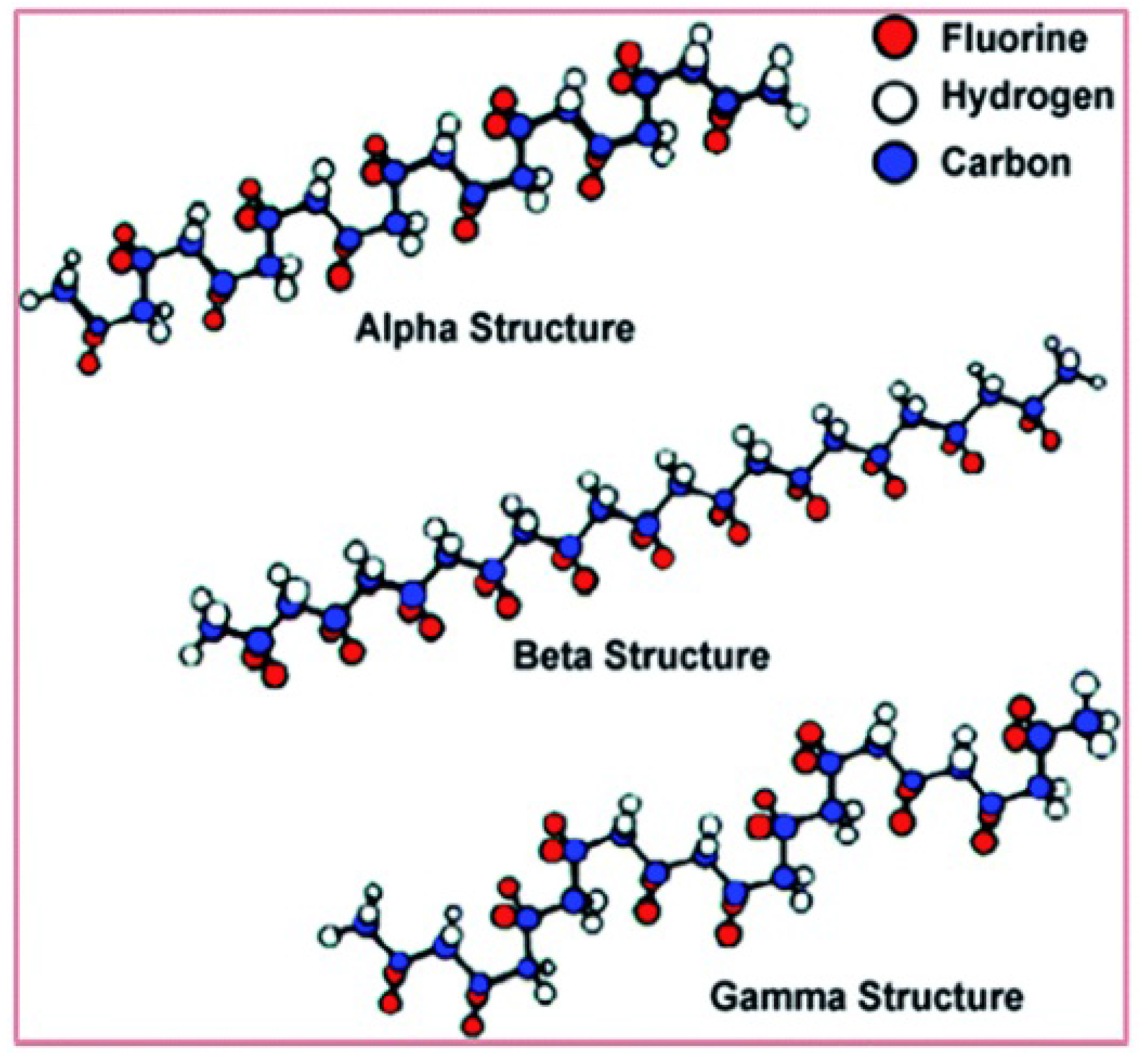

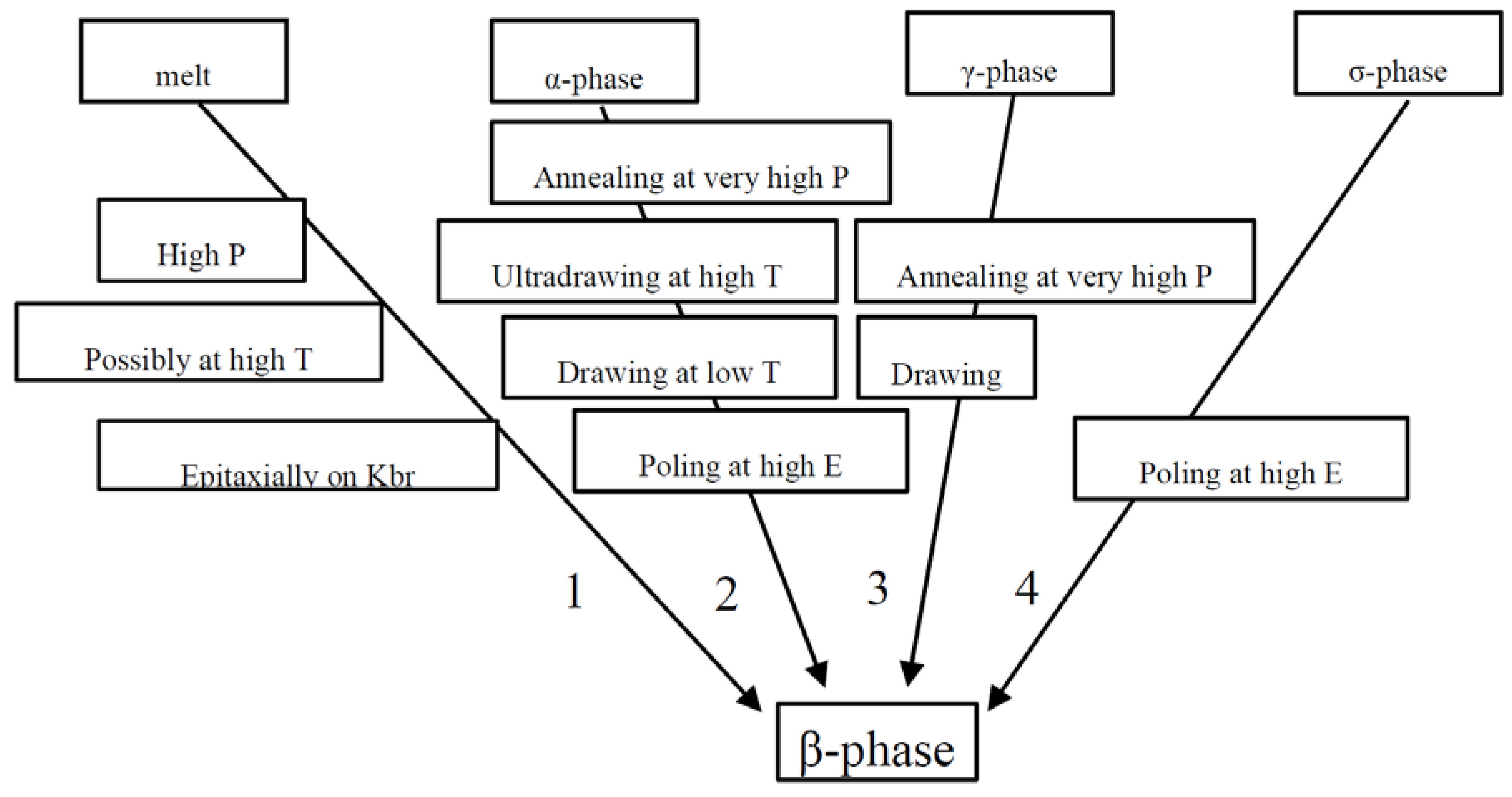
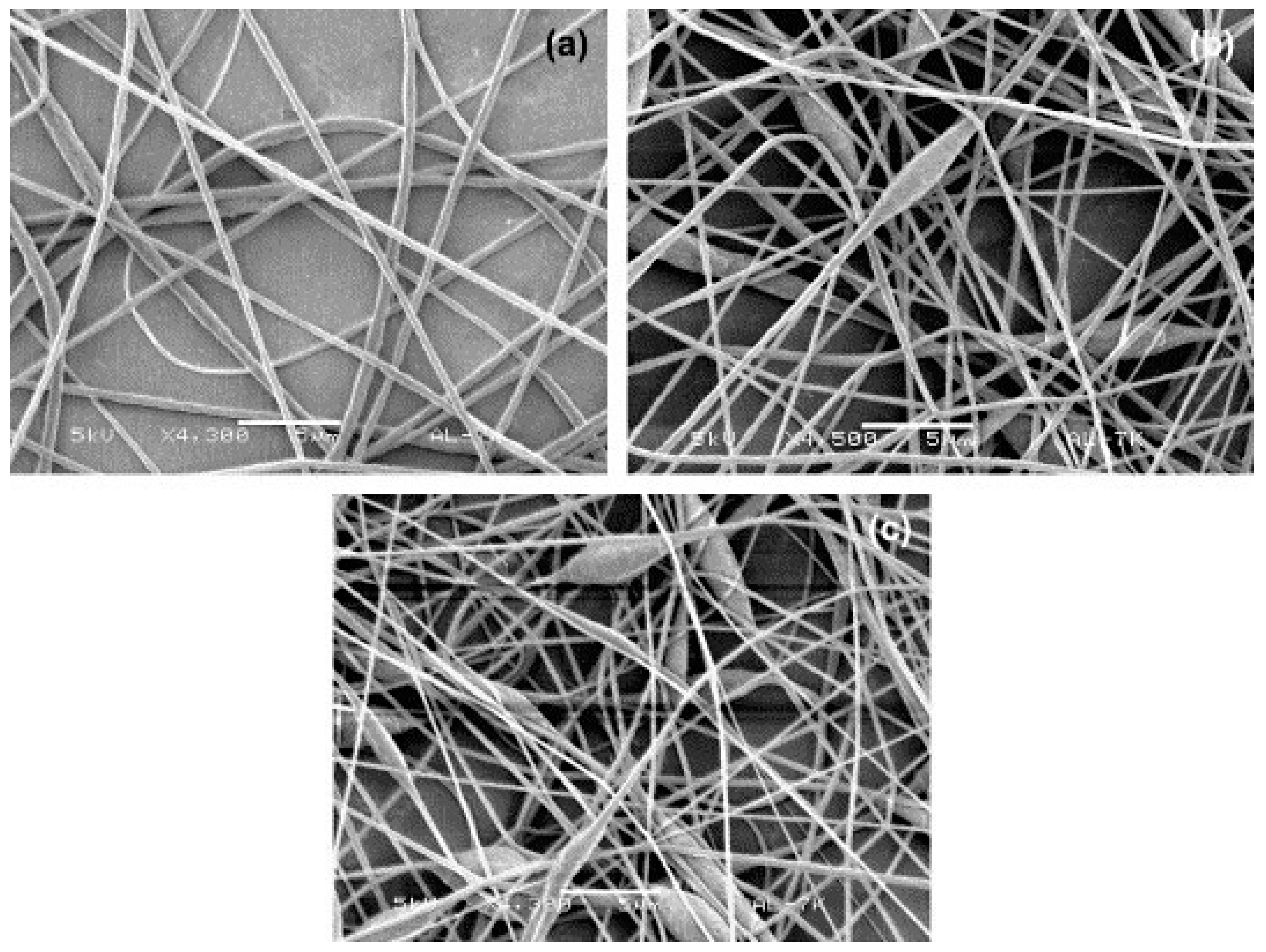
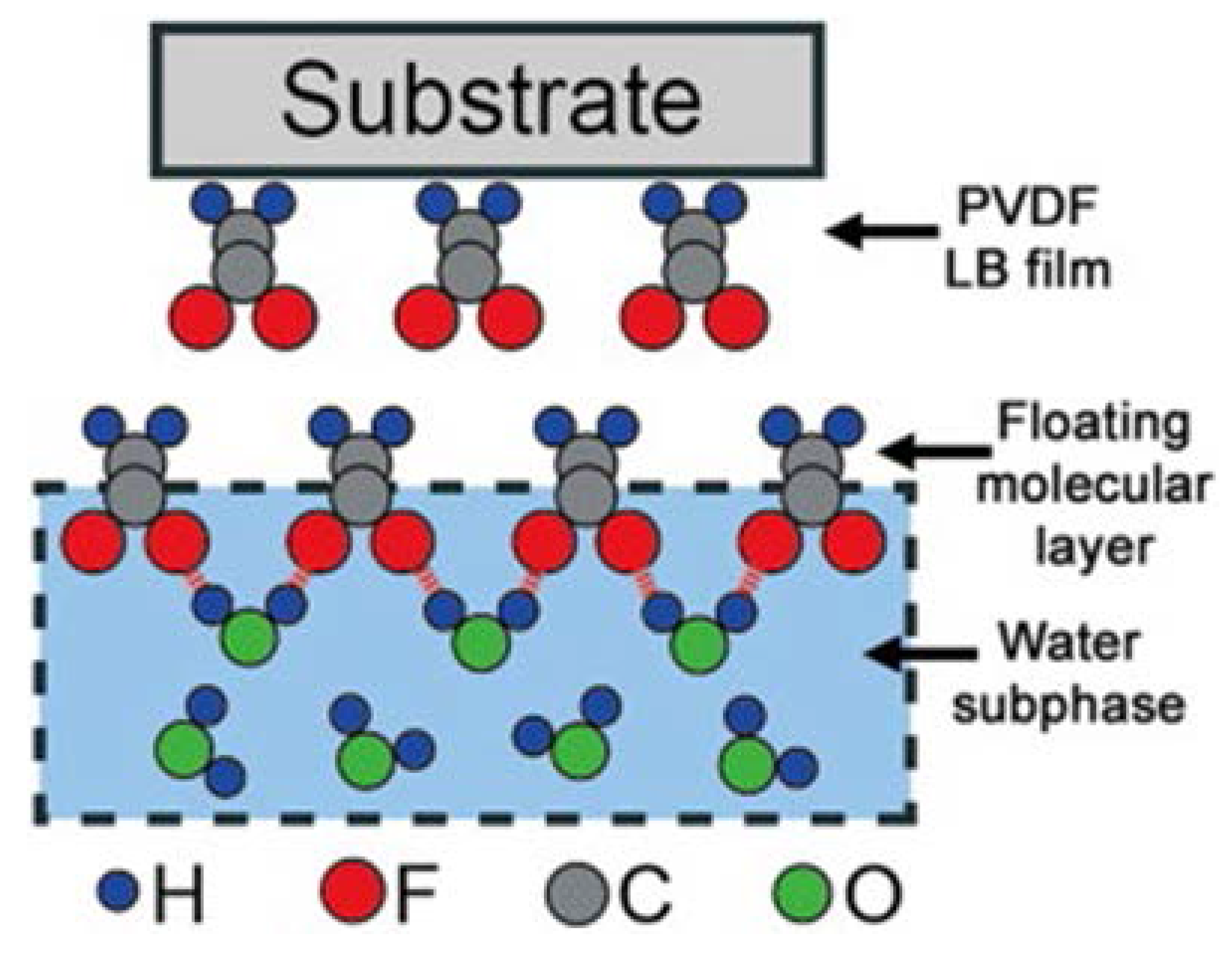
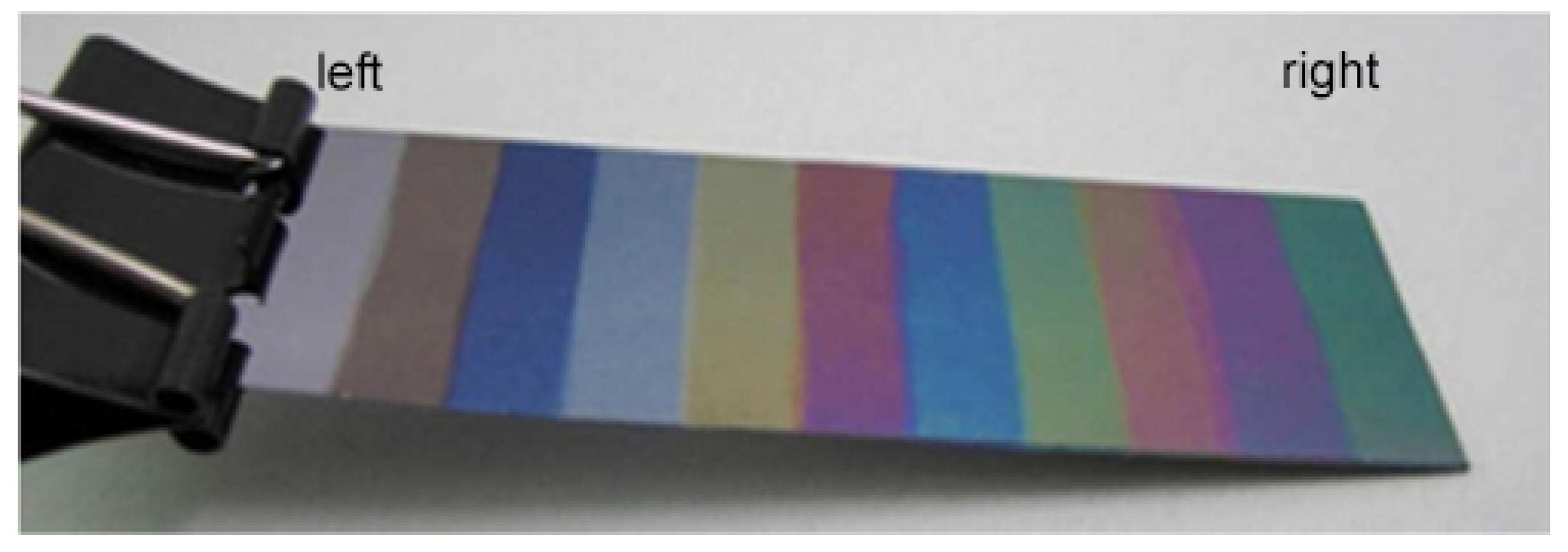
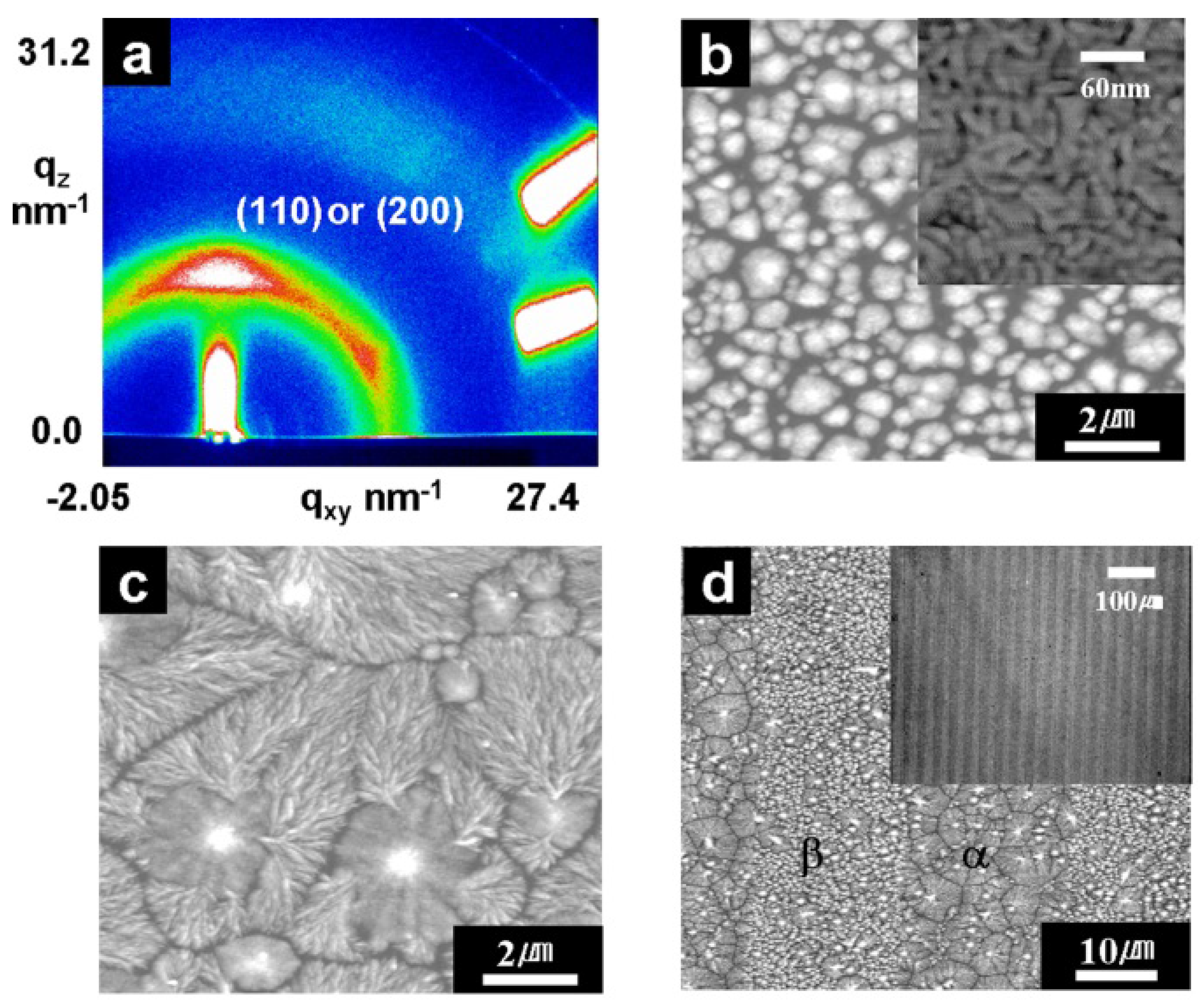


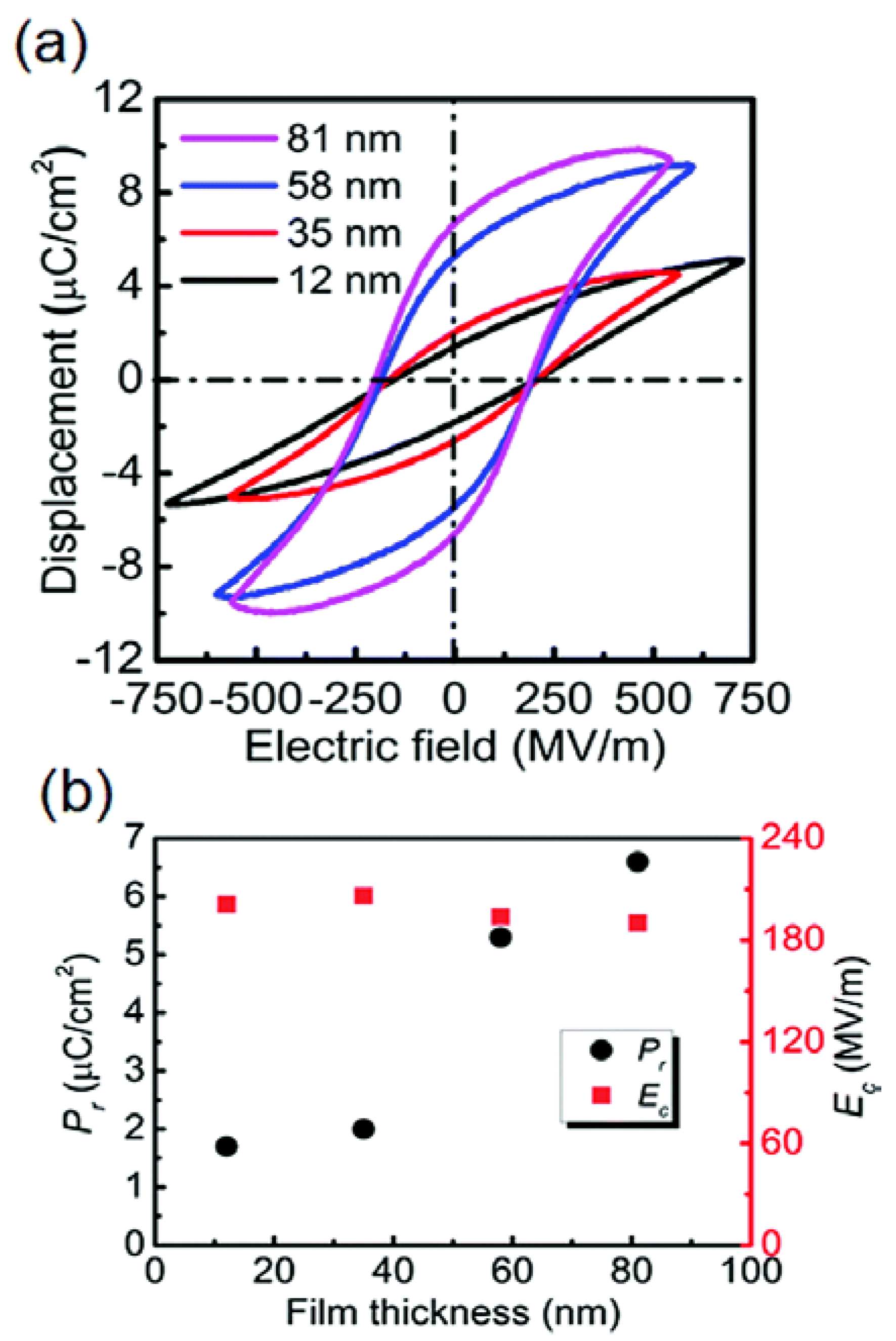
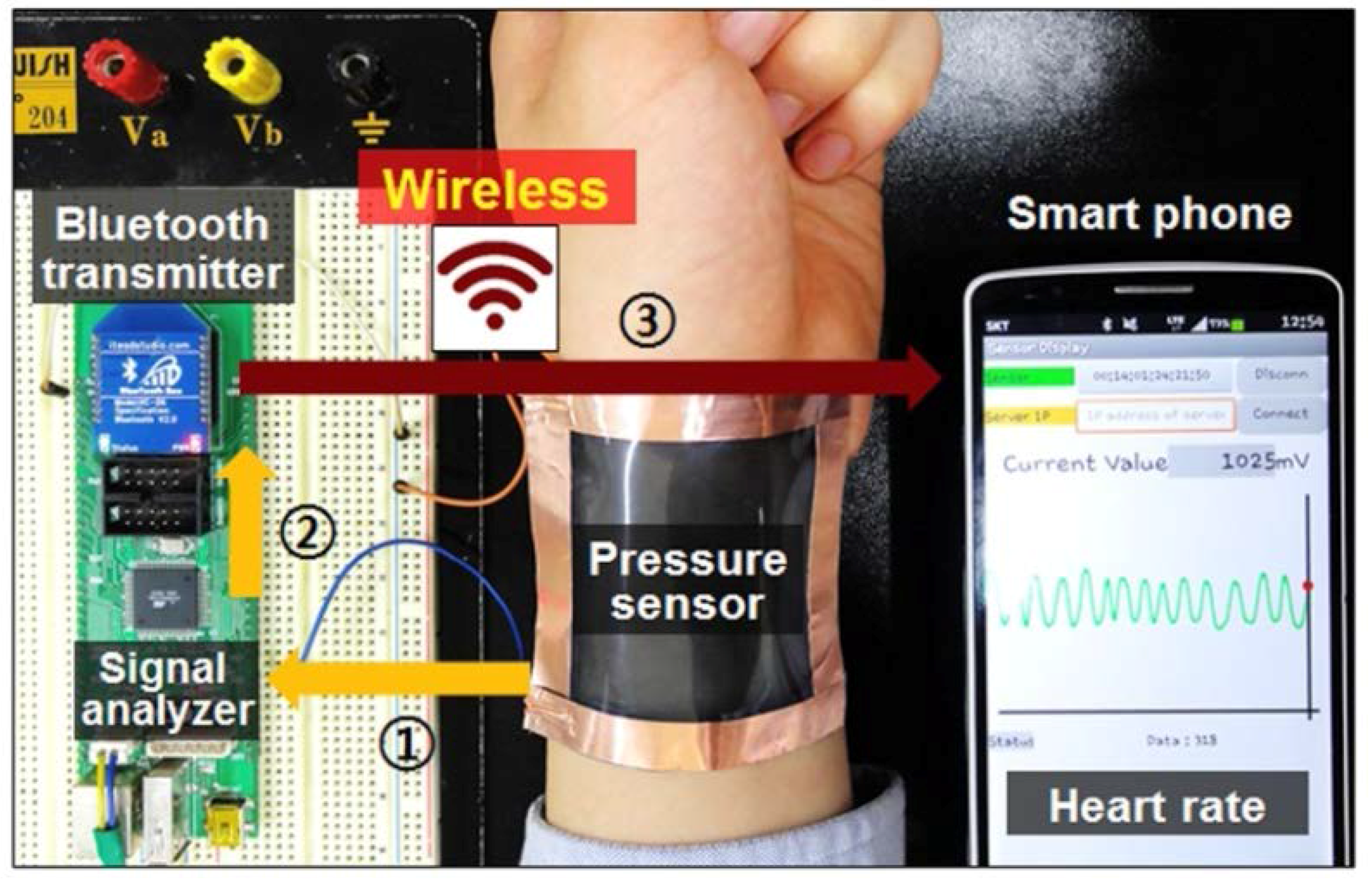
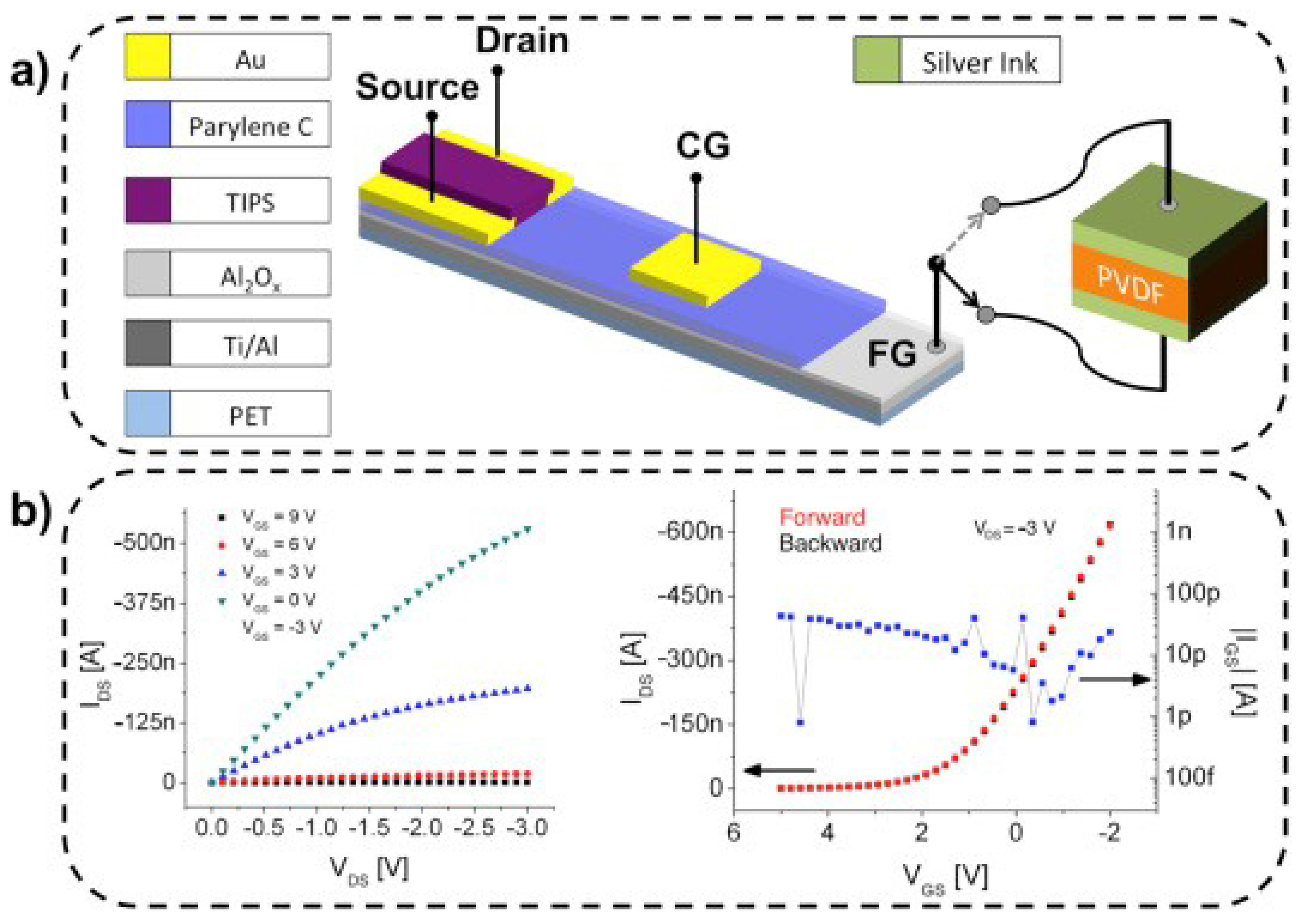
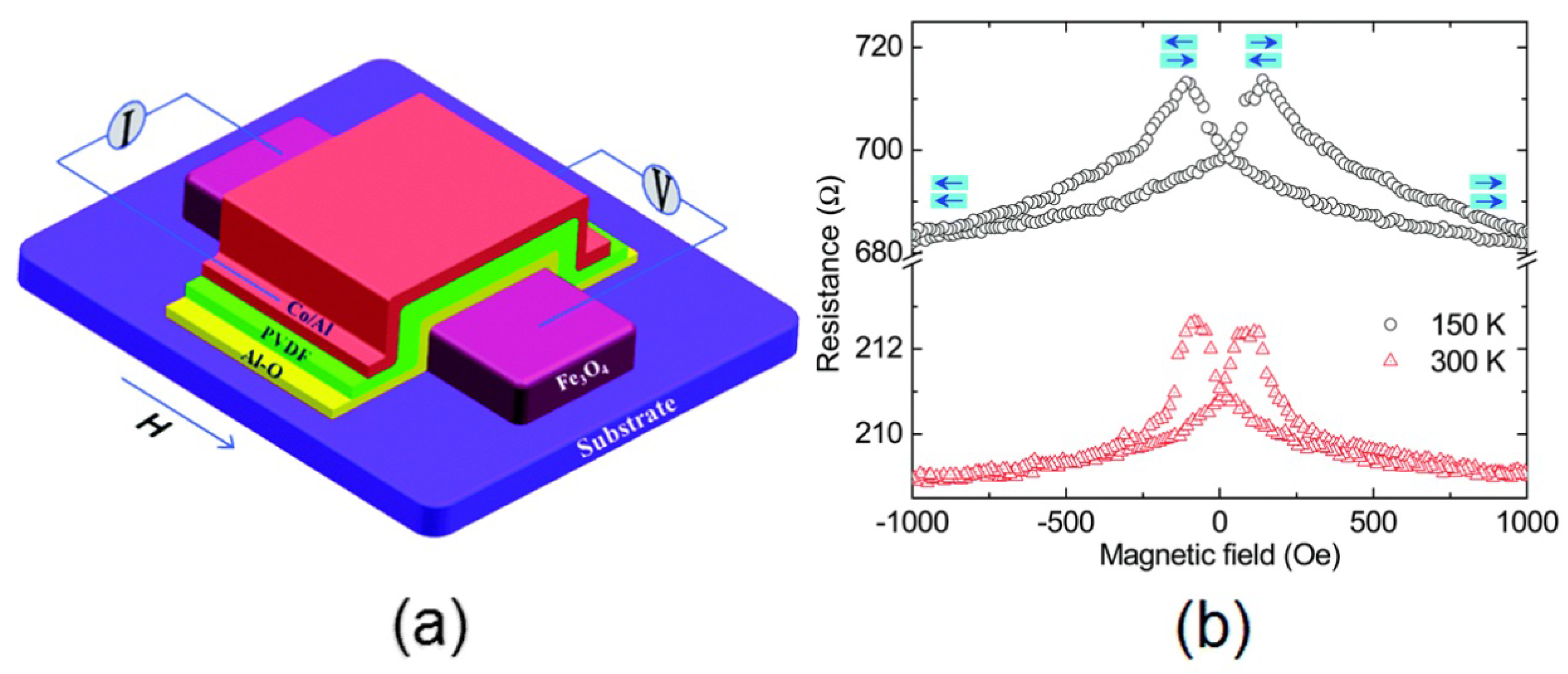
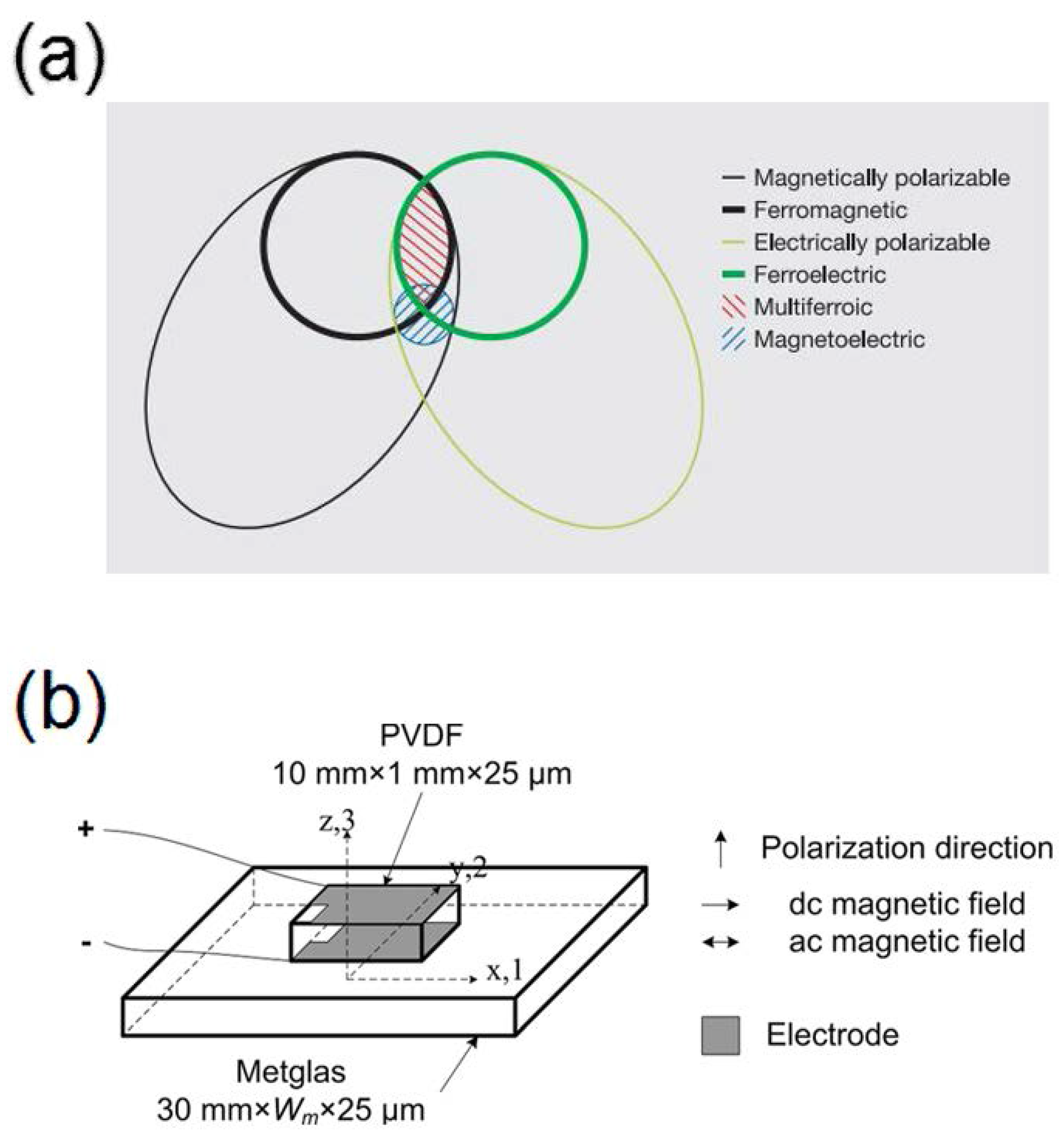
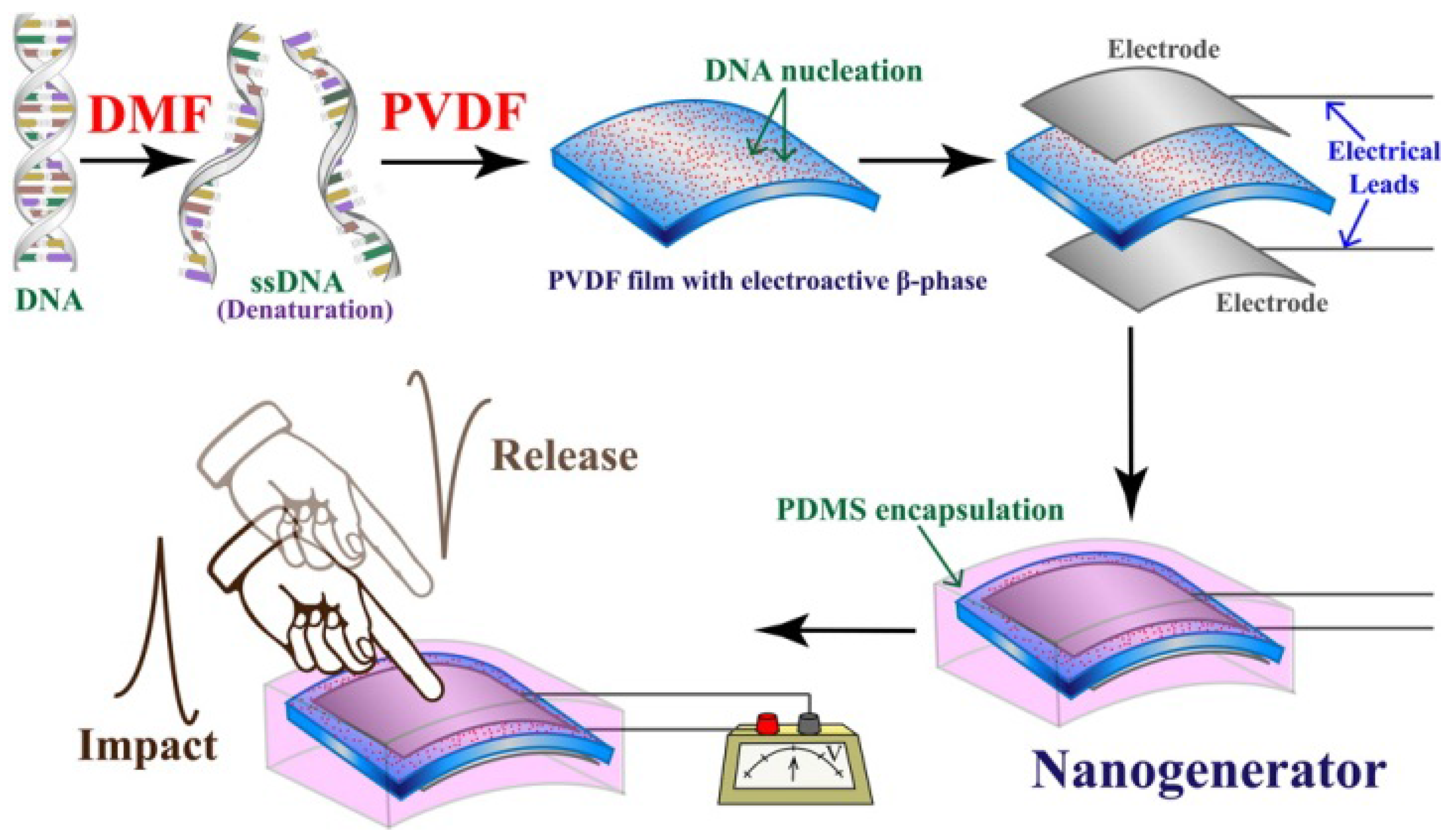

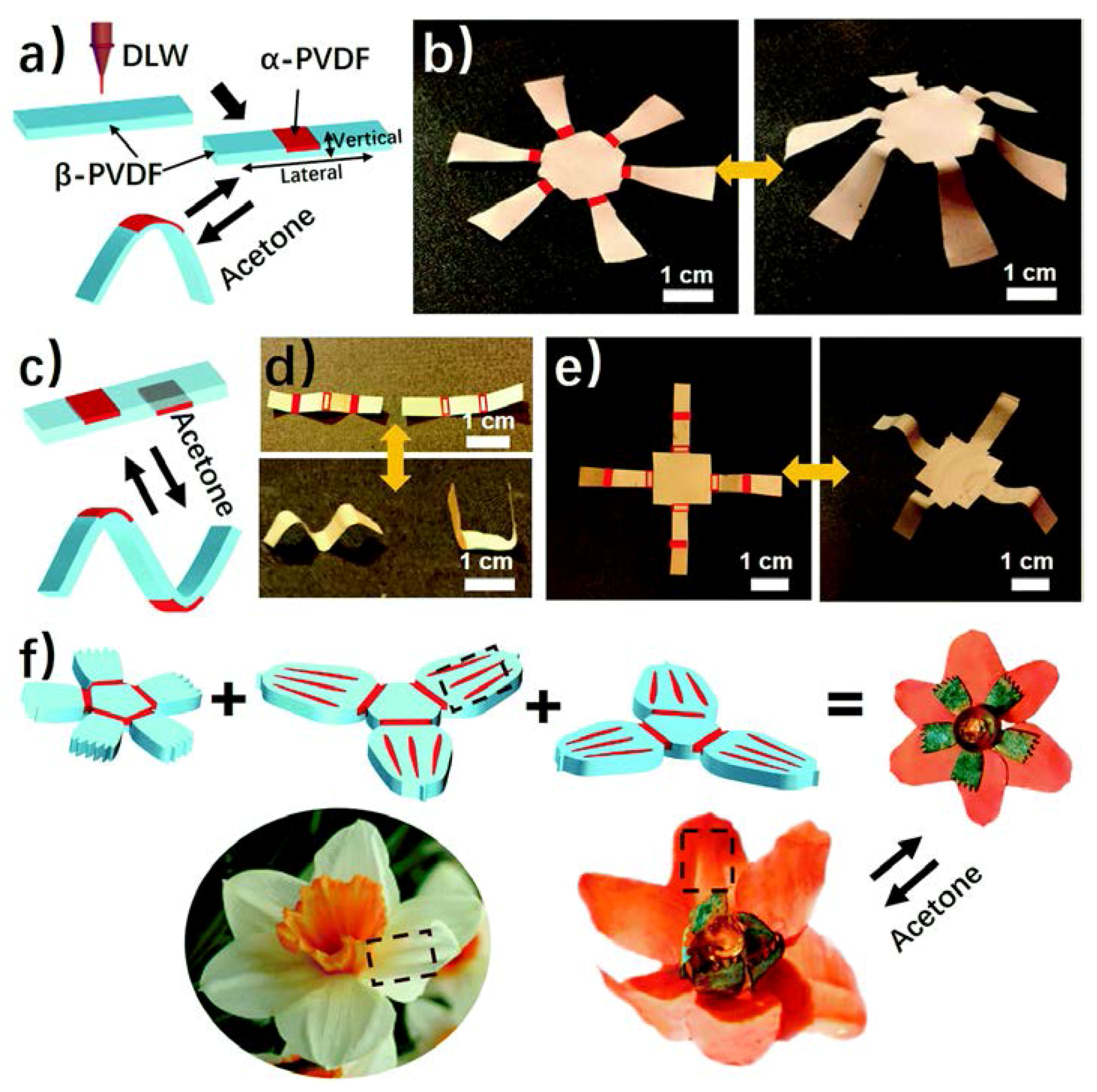
© 2018 by the authors. Licensee MDPI, Basel, Switzerland. This article is an open access article distributed under the terms and conditions of the Creative Commons Attribution (CC BY) license (http://creativecommons.org/licenses/by/4.0/).
Share and Cite
Ruan, L.; Yao, X.; Chang, Y.; Zhou, L.; Qin, G.; Zhang, X. Properties and Applications of the β Phase Poly(vinylidene fluoride). Polymers 2018, 10, 228. https://doi.org/10.3390/polym10030228
Ruan L, Yao X, Chang Y, Zhou L, Qin G, Zhang X. Properties and Applications of the β Phase Poly(vinylidene fluoride). Polymers. 2018; 10(3):228. https://doi.org/10.3390/polym10030228
Chicago/Turabian StyleRuan, Liuxia, Xiannian Yao, Yufang Chang, Lianqun Zhou, Gaowu Qin, and Xianmin Zhang. 2018. "Properties and Applications of the β Phase Poly(vinylidene fluoride)" Polymers 10, no. 3: 228. https://doi.org/10.3390/polym10030228
APA StyleRuan, L., Yao, X., Chang, Y., Zhou, L., Qin, G., & Zhang, X. (2018). Properties and Applications of the β Phase Poly(vinylidene fluoride). Polymers, 10(3), 228. https://doi.org/10.3390/polym10030228




